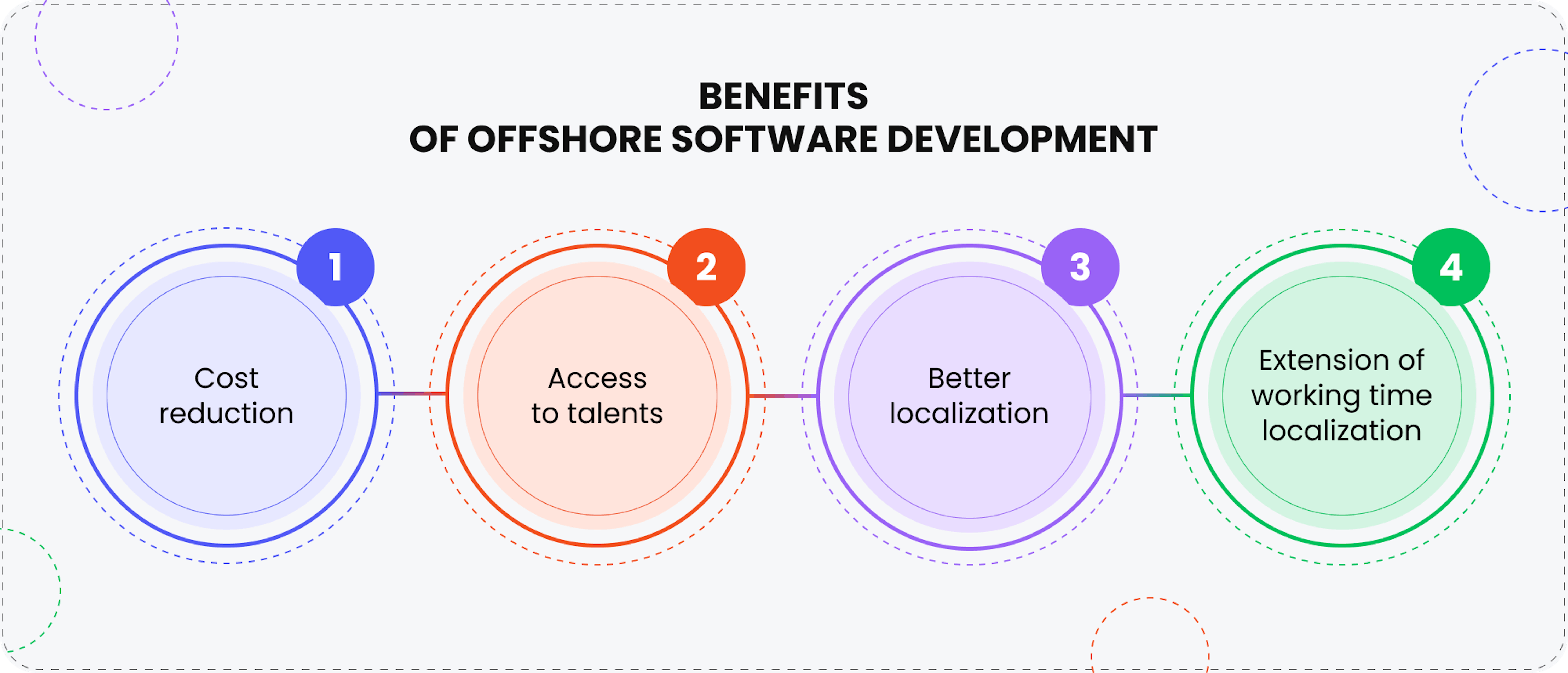The global tech landscape continues to evolve rapidly, and offshore software development remains a cornerstone strategy for companies seeking to optimize costs, access international talent, and accelerate their project timelines. If you're considering this approach in 2025, this guide will provide you with everything you need to know to make informed decisions.
What is offshore software development?
Offshore software development refers to outsourcing software development tasks to a team located in another country, often in a different time zone. By leveraging an offshore software development center, businesses can access a global talent pool, reduce costs, and accelerate project timelines while maintaining flexibility and scalability.

Offshore vs outsourcing
While offshore development focuses on hiring teams in distant locations to handle software tasks, outsourcing is a broader term that includes delegating tasks to external companies or teams, regardless of their location.
Offshore is a subset of outsourcing, characterized by geographical distance, whereas outsourcing can also involve nearshore (neighboring countries) or onshore (within the same country) teams. Choosing between these models depends on factors like budget, required expertise, and project complexity.
| FEATURE | OFFSHORE DEVELOPMENT | OUTSOURCING |
|---|---|---|
| Definition | Delegating software development to a team in another country | Delegating tasks to an external team (local, nearshore, or offshore) |
| Location | Distant country, different time zones | Can be onshore, nearshore, or offshore |
| Cost efficiency | High, due to lower labor costs | Varies depending on location |
| Best for | Companies looking for long-term, scalable solutions | Businesses needing temporary or specialized support |
Who should use OSD?
The offshore software development (OSD) strategy isn't limited to startups—it can be a game-changer for businesses of all sizes, including large enterprises. Here's a closer look at who stands to benefit most from leveraging the right OSD approach:
Startups and SMEs
With constrained budgets and small teams, startups and small-to-medium enterprises often struggle to access top-tier talent. OSD allows them to overcome this challenge by tapping into skilled professionals at a fraction of the cost of local hiring. This enables them to compete effectively without overstretching resources.
Companies seeking scalability
Mid-sized tech firms experiencing growth beyond their current development capacity can scale seamlessly with OSD. This approach provides the flexibility to expand operations without committing to the long-term overhead associated with local hires.
Organizations needing specialized skills
Large corporations often require niche expertise that may be hard to find—or prohibitively expensive—locally. OSD opens up access to a global talent pool, making it easier to acquire specialized skills and expertise at reasonable rates.
Businesses prioritizing time optimization
Companies aiming to accelerate their time-to-market, especially in rapidly evolving industries like finance, e-commerce, and healthcare, can benefit from OSD. Leveraging teams across time zones ensures continuous development and productivity, cutting down on project timelines.
Traditional businesses embracing digital transformation
Established businesses looking to stay competitive must integrate modern solutions into their operations. OSD provides a cost-effective way to drive digital transformation initiatives, allowing these companies to adopt new technologies without disruption.
Why choose offshore development in 2025?
The offshore software development market was valued at approximately USD 160.9 billion in 2024 and is expected to each USD 413 billion by 2033.

Offshore teams often operate in regions with lower labor costs, enabling significant savings without compromising on quality.
Companies gain access to a diverse range of expertise, from frontend development to AI/ML specialists.
Offshore development provides flexibility to scale your team up or down based on project needs.
In-house team to focus on strategic initiatives while offshore teams handle development tasks.
Teams in different time zones can ensure continuous progress, reducing time-to-market.
What are the drawbacks of offshore development?
Offshore development comes with challenges like communication barriers, quality control issues, and project management complexities, especially when coordinating in-house and external teams. Data security risks, hidden costs, and dependency on offshore providers can also impact efficiency and long-term agility. Let's elaborate:
- Communication barriers — Differences in language and time zones can lead to misunderstandings and delays if not managed effectively. Variations in work culture and business practices may require time to align expectations.
- Quality control — Ensuring consistent quality can be difficult without robust monitoring and clear specifications.
- Project management challenges — Managing projects with both in-house and offshore specialists adds complexity, particularly in maintaining clear documentation and providing full task context.
- Data security risks — Sharing sensitive data with external teams increases the risk of breaches or non-compliance with regulations.
- Hidden costs — Unforeseen expenses, such as travel or additional project management, can reduce cost savings.
- Dependency on external teams — Over-reliance on offshore providers may impact agility and in-house expertise.
Key trends in offshore development
The offshore development landscape continues to evolve, driven by technological advancements and shifting business priorities. In 2025, several key trends are shaping how companies approach offshore software development:
Increased use of AI and automation — AI-driven tools optimize workflows, from code generation to quality assurance.
Focus on cybersecurity — As cyber threats grow, offshore providers are prioritizing robust security measures.
Hybrid models — Combining in-house, nearshore, and offshore teams to maximize efficiency.
Specialized skillsets — Demand for expertise in areas like blockchain, IoT, and cloud-native development continues to rise.
Sustainable development practices — Providers increasingly adopt green coding practices and energy-efficient solutions.
Offshore development team structure
Offshore development teams are structured to match different project needs, ensuring efficiency, scalability, and expertise. While dedicated teams offer long-term support for ongoing projects, project-based teams focus on delivering specific, one-time assignments.
Regardless of the model, a well-structured team includes key roles such as project managers, developers, and quality assurance engineers to ensure smooth execution and high-quality delivery.
Team models: dedicated vs. project-based teams
A well-structured offshore development team can follow one of two primary models:
Dedicated development team
A dedicated team functions as a seamless extension of the client’s in-house workforce. They integrate with company processes, align with business objectives, and work on long-term projects that require flexibility and specialized skills over time. This model is best suited for:
- Evolving, complex projects that require continuous development and updates.
- Companies looking for long-term engagement with a stable team.
- Businesses needing specialized expertise that is difficult to hire in-house.
Project-based team
A project-based team is assembled for a single, well-defined project with specific objectives and a fixed timeline. Once the project is completed, the team disbands or moves on to new assignments. This model is ideal for:
- One-time projects with fixed requirements, such as mobile apps, websites, or software features.
- Startups or businesses needing rapid development without long-term commitments.
- Companies with clear deliverables and predefined deadlines.
Both models offer unique advantages, and choosing the right one depends on the project\s complexity, timeline, and need for long-term engagement.
Top 5 countries for offshore development in 2025
Offshore software development continues to thrive, with companies leveraging global talent pools to optimize costs and accelerate innovation. Here's a look at the top destinations for offshore development in 2025:
1. India
Strengths:
- Largest talent pool with over 5.2 million software developers.
- Cost-effective services with high-quality output.
- IT exports valued at $200 billion in 2024.
- Strong expertise in software development, cloud computing, and AI.
Why it's a top choice:
- Established IT hubs like Bangalore, Hyderabad, and Pune.
- Government initiatives like Digital India boost the tech ecosystem.
Rates: Hourly rates ranging from $20–50 for skilled developers.
2. Eastern Europe
Strengths:
- Approximately 1.2 million highly skilled developers.
- Expertise in emerging technologies like AI, blockchain, and cybersecurity.
- Tech sector growth of 15% year-over-year.
Why it's a top choice:
- Countries like Poland, Ukraine, and Romania offer a strong talent pool.
- Cultural and time zone alignment with Western Europe.
Rates: Hourly rates range from $30–50, but depends on the country and expertise.
3. Latin America
Strengths:
- Close proximity to the U.S. and cultural alignment.
- Brazil and Mexico lead with IT services exports exceeding $30 billion annually.
- IT Outsourcing projected market volume of $19.54bn in 2025.
Why it's a top choice:
- Strong nearshore outsourcing hub for U.S. companies.
- Growing expertise in software development, mobile apps, and fintech.
Rates: Hourly rates range from $30–60
4. Southeast Asia
Strengths:
- Emerging IT hubs in the Philippines, Vietnam, and Malaysia.
- IT services industry valued at $12 billion in 2025.
- Competitive pricing and skilled talent pool.
Why it's a top choice:
- Government-backed digital initiatives drive growth.
- Strong English proficiency in countries like the Philippines.
Rates: Hourly rates range from $20–30, one of the most affordable options available
5. South Africa
Strengths:
- The IT sector is rapidly growing, and in 2021, it reported having over 700,000 software developers across the continent.
- Key hubs are Nigeria, Egypt, Morocco, and Kenya
Why it's a top choice:
- Services are cost effective with competitive developer rates.
- Nigeria and Kenya are showing growing innovation in fintech, AI and mobile development.
- Government support to tech ecosystems is strong with initiatives like Smart Africa and tech hubs in major cities.
Rates: Hourly rates range from $20–40, making it a competitive offshore destination.
Best practices on how to hire offshore software developers
Hiring offshore software developers can be a cost-effective way to access global talent, but it requires careful planning to ensure a successful collaboration. Here's a step-by-step guide to finding and working with the right offshore development team.
Define project requirements
✔ Outline project goals, deliverables, and milestones.
✔ Specify the required tech stack and development needs (frontend, backend, or full-stack).
✔ Prepare a detailed Product Requirements Document (PRD) to guide the process.
Research offshore destinations
✔ Compare hourly rates across regions
✔ Evaluate the availability of skilled developers and cultural compatibility.
✔ Consider time zones to ensure smooth communication.
Vet potential development teams
✔ Review portfolios, case studies, and client feedback for reliability and expertise.
✔ Conduct technical interviews and coding assessments.
✔ Test English proficiency to ensure clear communication.
Assess development processes and tools
✔ Align on development methodologies (Agile, Scrum etc.).
✔ Verify the use of version control tools, project management platforms (Jira, Trello), and QA processes.
✔ Ensure proper documentation standards are followed.
Set communication & reporting standards
✔ Define communication channels (Slack, Teams) and reporting frequency.
✔ Use task management tools to track progress. Enji.ai offers advanced analytics to track work activity, identify bottlenecks, and ensure transparency across hybrid teams. With features designed to optimize collaboration and productivity, it's the ultimate tool to manage your offshore development team efficiently.
✔ Assign a project manager to oversee daily operations.
Negotiate contracts & legal protections
✔ Draft clear contracts detailing scope, payment terms, and intellectual property (IP) ownership.
✔ Include Non-Disclosure Agreements (NDAs) to secure sensitive information.
✔ Ensure compliance with local labor and tax laws.
Start with a pilot project
✔ Assign a small, self-contained task to evaluate the team's skills, communication, and timeliness.
✔ Use the pilot as a basis for a long-term engagement if successful.
Security considerations in offshore software development
Security is a critical aspect of offshore software development, where sensitive data, intellectual property (IP), and business operations must be safeguarded. Organizations outsourcing development to offshore teams must proactively address risks related to data breaches, regulatory compliance, and vendor security practices. Implementing strong security protocols helps mitigate these risks, ensuring a secure and successful partnership.
Below are the key security considerations for offshore software development:
Protecting intellectual property (IP) and data
One of the biggest concerns in offshore software development is securing IP and sensitive data. The involvement of external teams, especially across different jurisdictions, increases the risk of unauthorized access, data theft, or loss of proprietary information. Companies must take the following measures to safeguard their assets:
- Non-Disclosure Agreements (NDAs) — Ensure all offshore partners sign comprehensive NDAs outlining their responsibilities regarding IP protection and data confidentiality.
- Data encryption — Use industry-standard encryption protocols like AES-256 for data at rest and TLS 1.3 for data in transit to protect sensitive information.
- Access control — Implement role-based access control (RBAC) to limit data access based on job responsibilities, ensuring offshore teams only access what they need.
- IP Ownership clauses — Clearly define IP ownership in contracts, stating that the client retains full rights over all code, designs, and processes developed.
- Regular security audits — Conduct periodic security audits (internally or via third-party experts) to ensure offshore teams adhere to security best practices.
Ensuring compliance with global regulations
Offshore development often involves handling data subject to various global regulations, including:
GDPR (Europe)
For companies managing EU citizens' personal data, compliance with General Data Protection Regulation (GDPR) is mandatory. Key requirements include:
- Obtaining explicit consent for data collection.
- Ensuring data portability and the right to be forgotten.
- Enforcing strict contractual obligations for offshore vendors to align with GDPR policies.
HIPAA (United States)
Healthcare-related projects must comply with Health Insurance Portability and Accountability Act (HIPAA), which mandates:
- Encryption of patient data.
- Secure authentication measures.
- Strict access controls and logging mechanisms.
Data residency laws
Certain countries require that sensitive data remain within their borders. Offshore teams must understand these regulations and design systems accordingly to ensure compliance.
Compliance certifications
Offshore vendors should possess security certifications such as ISO 27001 (information security management) or PCI DSS (payment security) to demonstrate adherence to industry standards.
Auditing and vetting security protocols
Organizations must evaluate their security capabilities before partnering with an offshore development team. A structured vetting process includes:
- Security questionnaires — Request vendors to complete a detailed security questionnaire covering encryption methods, access control, and incident response procedures.
- On-site audits — Where feasible, conduct on-site assessments to evaluate physical and digital security practices.
- Certification verification — Request documentation of industry-standard certifications (e.g., ISO 27001, PCI DSS) to ensure adherence to global security norms.
- Incident response plans — Ensure the offshore vendor has a structured incident response plan detailing how security breaches will be handled, reported, and mitigated.
A security-first approach protects intellectual property and sensitive data and ensures compliance with global regulations, fostering trust and long-term success in offshore collaborations.
To wrap up
Offshore software development will grow in 2025 and provide many ways for businesses to innovate and cut costs. To achieve long-term success in the global market, companies must understand the environment, follow best practices, and select the right offshore partner.
At Mad Devs, we offer top-notch offshore software development services and contribute to the growth and enhancement of efficiency of businesses through a well-documented process of delivering complex, feature-rich software solutions.
Looking for a reliable offtaker? We would love to hear about your project, let's talk! We offer free consultation, so feel free to contact us to find out how we can help further your business objectives.











